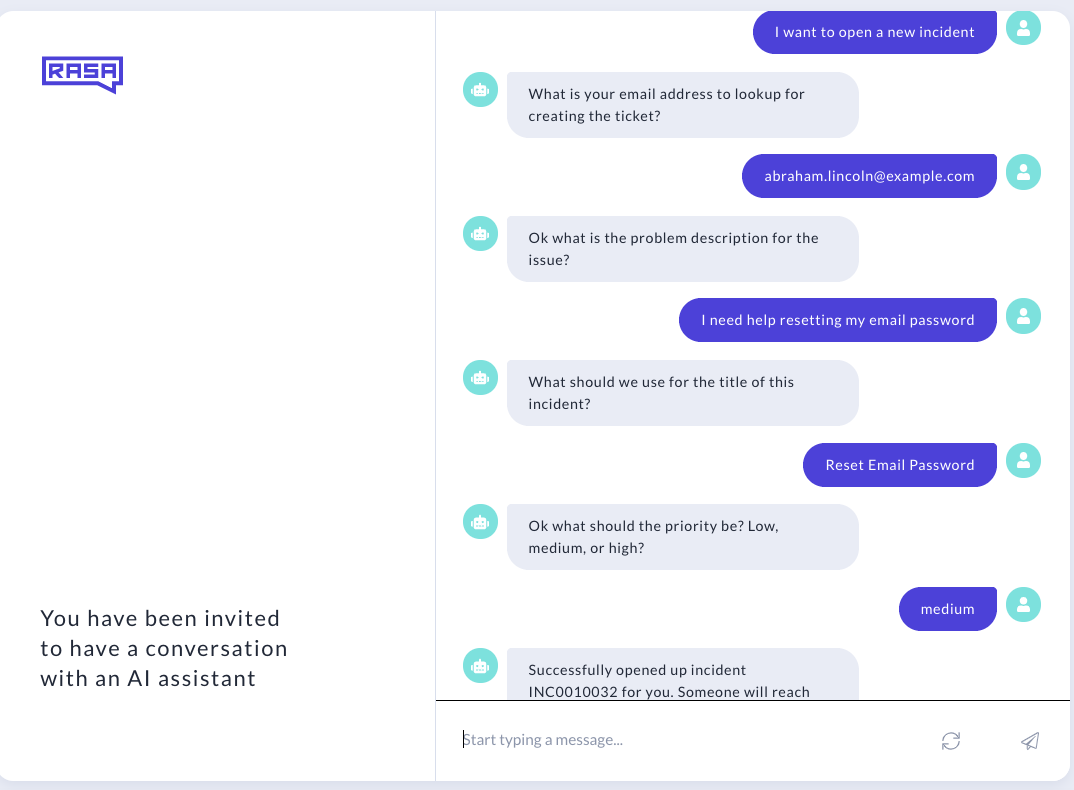This is a basic demo bot showing Rasa with Service Now API calls to open incidents.
Here is an example of a conversation you can have with this bot:
In a Python3 virtual environment run:
pip install -r requirements.txtYou can run this bot without connecting to a ServiceNow instance, in which case it will
send responses without creating an incident. To run the bot without connecting ServiceNow,
you don't need to change anything in snow_credentials.yml; localmode should already be set
to true
If you do want to connect to ServiceNow, you can get your own free Developer instance to test this with here
To connect to your ServiceNow instance, configure the following in snow_credentials.yml:
-
snow_instance- This is just the instance address, you don't need the leading https. -
snow_user- The username of the service account this action code will use to open a incident. -
snow_pw- The password of the service account this action code will use to open a incident. -
localmode- Whether the action server should not try to reach out to asnow_instancebased on the credentials insnow_credentials.yml. When set toTrue(default in the code), it will just take all the data in and message out the information that would normally be sent.
Use rasa train to train a model.
Then, to run, first set up your action server in one terminal window:
rasa run actionsIn another window, run the duckling server (for entity extraction):
docker run -p 8000:8000 rasa/ducklingThen to talk to the bot, run:
rasa shell --debugNote that --debug mode will produce a lot of output meant to help you understand how the bot is working
under the hood. You can also add this flag to the action server command. To simply talk to the bot, you can remove this flag.
The bot has one main skill, i.e. opening an incident in ServiceNow. For the purposes of illustration, the bot recognizes the following as requests to open an incident:
- Asking to open an incident directly e.g. "I want to open an incident"
- Asking about a problem resetting their password e.g. "I can't reset my password"
- Asking about a problem with outlook/email e.g. "I can't log in to my outlook"
Take a look at data/nlu.md to see what the bot is currently trained to recognize.
It can also respond to requests for help (e.g. "help me")
With localmode=True:
Bot loaded. Type a message and press enter (use '/stop' to exit):
Your input -> hi
Hello
I can help you open a service request ticket. You can ask me things like "Open an incident",
"Help me reset my password", or "I'm having a issue with my email."
Your input -> i have a problem with my email
What is your email address to lookup for creating the incident?
Your input -> [email protected]
? What is the priority of this issue? 3: high (/inform{"priority":"high"}) # This is a button
What is the problem description for the issue?
Your input -> can't log in to outlook
An incident with the following details would be opened if ServiceNow was connected:
email: [email protected]
problem description: can't log in to outlook
title: Problem with email
priority: high
Your input -> bye!
ByeWith localmode=False:
With a Service Now instance connected, it will check if the email address is in the instance database and provide an incident number for the final response:
Your input -> help me reset my password
What is your email address to lookup for creating the incident?
Your input -> [email protected]
Sorry, "[email protected]" isn't in our incident management system. Please try again.
What is your email address to lookup for creating the incident?
Your input -> [email protected]
? What is the priority of this issue? Type out your own message...
Your input -> low
Successfully opened up incident INC0010016 for you. Someone will reach out soon.
Your input -> thanks!
You're welcome!A Dockerfile is provided, so you can build a docker image for the action server, to use in production deployments.
To build the image:
docker build . -t <name of your custom image>:<tag of your custom image>To test the container locally, you can then run the action server container with:
docker run -p 5055:5055 <name of your custom image>:<tag of your custom image>Once you have confirmed that the container works as it should, you can push the container image to a registry with docker push
It is recommended to use an automated CI/CD process to keep your action server up to date in a production environment.
